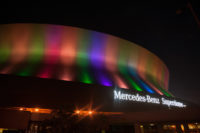Establishing a Winning Game Plan for Super (Bowl) Security

On February 7, the biggest football game of the year will take place at Levi’s Stadium in Santa Clara, California. While the Super Bowl is always a massive security undertaking, recent world events have put an even larger emphasis on locking down the game.
Of course, security directors for the Super Bowl – or any major sporting event, for that matter – must strike a balance between ensuring spectators’ safety while providing an enjoyable fan experience. That challenge becomes magnified in an event that will draw some 70,000 people in person and millions more on TV.
As local officials collaborate with federal agencies like FEMA and the FBI, they are developing a blueprint that takes into consideration fan expectations, traffic flow and safety. It’s a blueprint that all security directors in charge of sporting events can emulate by adhering to a few core tenets.
Establish an appropriate “clean area.” Security officials must determine and designate a secure zone that establishes a perimeter for where security measures should be put into place. At Levi’s Stadium and other sports facilities, this could include parking lots and entrances.
It’s important to note that there are pro’s and con’s to establishing smaller or larger clean areas. For instance, any outdoor security processes could be impeded by weather (if it’s raining, people may not want to remove their jackets). Conversely, while people might be more comfortable being screened after entering the facility, the venue could be exposed to a breach. All tradeoffs must be considered.
Remember that the fan experience begins in the queue. Ensure that security and event staff kick off the experience off in a positive manner. Staff should be vigilant, friendly and respectful. Keep the lines moving, be safe and make spectators feel comfortable.
Educate spectators before they come to the game. Prior to the game, security personnel and stadium and team ownership groups should consider implementing marketing campaigns to help people understand what they are allowed to bring and the types of security measures they can expect. These can include billboards; game day ads; notices on tickets, websites and apps; news features; and public transportation advertisements. Doing so can play a significant part in enhancing the fan experience and making the security process flow more smoothly.
Create unique screening lanes. While pre-event education can help the screening process go more smoothly, managers can make additional enhancements to further ensure a safe and fan-friendly experience. In addition to setting up tables, chairs and barriers to help direct people, lockers for storing prohibitive items should be easily accessible. There should also be unique lanes for those who may need additional assistance. Family screening lanes can be established so that children can receive kid-friendly treatment, perhaps with the help of mascots. Lanes for those with disabilities or the elderly can also be set up, as can lines for season ticket holders.
In all cases, security personnel must keep in mind that shorter lines are less daunting to fans. Longer lines can be potentially alarming and frustrating and disrupt traffic flow. Personnel must keep the lines manageable.
Invest in an array of high-end equipment. Well-publicized sporting events require a higher level of equipment rather than simply relying on walk through metal detectors and X-ray machines. Since terrorists are increasingly creative in their lethality, event security directors must use equipment designed to detect other threats, including radioactive and nuclear devices. Directors will also need solutions that scan for trace amounts of explosive materials that could appear on individuals’ clothing that X-ray or basic security systems would not detect.
In addition to spectators, there are thousands of vendors that must be considered. Food, clothing and other types of sports paraphernalia will be entering the stadium. Security experts will also want to deploy equipment that monitors Chemical Vulnerability Information and aids in oversize pallet and cargo screening, similar to what was done for last year’s Super Bowl. These items must be screened securely and quickly, without adversely affecting the ability for vendors to easily get their wares into the stadium.
Securing the Super Bowl will be a monumental task, but it’s the sheer size and complexity of that task that makes it an excellent study for those that have to deal with everyday event security challenges. It’ll also serve as an excellent guide for directors in charge of next year’s Super Bowl in Houston, only one year away. After all, memories should be of events that occurred on, not off, the field.
Looking for a reprint of this article?
From high-res PDFs to custom plaques, order your copy today!





